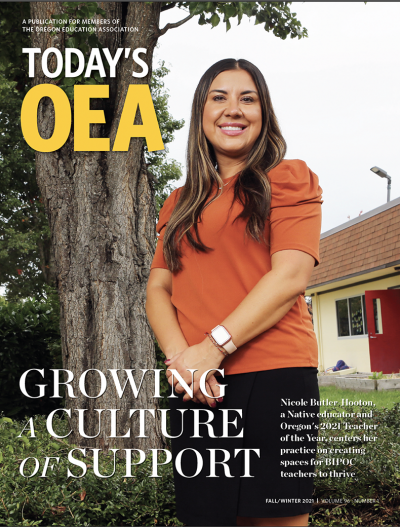Educators this fall have cause to celebrate. For 2016-17, teachers do not have to use Smarter Balanced Assessment results to measure their Student Learning and Growth goals. This change is a signal that Oregon is on a new path to building a better system of assessment that measures student learning and supports student growth.
This change to Oregon’s evaluation system marks the second year teachers in tested subjects and grades do not have to use the results of the summative assessment as a portion of their evaluation.
Educators must still write two Student Learning and Growth goals (SLG goals) for the 2016-17 school year, but educators can select the measure they will use to determine if they met those goals, meaning they can use classroom measures that more accurately reflect how students are learning and growing in their classes.
Educators can still use Smarter Balanced Assessments in grades 4-8 for English and math if they want to. These are known as Category 1 measures and again, they are optional.
OEA does not recommend using Smarter Balanced Assessments to measure SLG goals for two main reasons. First, these tests were not designed to measure how effective an individual teacher’s instruction is. Second, the Smarter Balanced Assessments don’t provide teachers or students with enough information about how students are doing on specific standards. So teachers and students can’t make decisions about how to adjust instruction or where to ask for help.
Instead of using Smarter Balanced, teachers can use Category 2 measures, which are assessments connected to the classroom: what teachers are teaching, and what students are learning. The Oregon Department of Education lists the follow- ing types of assessments as Category 2 measures:
- Additional state wide assessments like the science, social sciences, or English
Language Proficiency assessments; - Commercially developed assessments that include pre- and post-measures;
- Locally developed assessments that include pre- and post-measures;
- Results from proficiency-based assessment systems;
- Or locally developed collections of evidence, i.e. portfolios of student work that include multiple types of performance (Source: Oregon Department of Education Guidance for Setting Student Learning and Growth (SLG) Goals, Revised August 2016)
Any measure you use to evaluate whether or not you met your SLG goals should be a quality assessment that meets the Oregon Department of Education Criteria for High Quality Assessments, available online at www.ode. state.or.us/search/page/?id=512.
History of SLGs
Back when Oregon first received a federal waiver from No Child Left Behind’s accountability system, the state had to agree to overhaul its evaluation system for educators and administrators, including linking educator evaluations to summative test scores. The resulting legislation was Senate Bill 290, passed in 2011.
Under SB 290, the evaluation system included five components:
- Standards of professional practice;
- Differentiated performance levels;
- Multiple measures of evidence;
- Evaluation and professional growth cycle;
- And aligned professional learning.
The multiple measures provision called for three measures of evidence to evaluate educators: evidence of professional practice, professional responsibilities, and student learning and growth. Evidence of student learning and growth became the Student Learning and Growth goals teachers have been writing since the 2013-14 school year.
The End of NCLB
In December 2015, President Barack Obama signed the Every Student Succeeds Act into law, which effectively ended the era of No Child Left Behind. Additionally, all state waivers and the requirements that went with those waivers, expired on Aug. 1, 2016. That includes the requirement to link summative statewide test scores to evaluations.
The Every Student Succeeds Act, or ESSA, does not include the same requirement to link student test scores to evaluations. In fact, the law specifically prohibits the federal U.S. Department of Education from mandating any aspect of a state educator evaluation system. ESSA returns decision making about evaluations back to states, where it belongs.
As the Oregon Department of Education worked with education partners including OEA to read and interpret this new education law, it issued guidance in April 2016 making the use of Smarter Balanced Assessment results optional for Student Learning and Growth goals.
This August, ODE issued further guidance for the 2016-17 school year. Once again, educators do not have to use Smarter Balanced Assessment results to measure their Student Learning and Growth goals unless they choose to.
More Changes on the Horizon
Later this fall and winter, ODE will be proposing rule changes to SB 290, the evaluation law, to the State Board of Education. OEA members and staff have been involved with proposing those rule changes so Oregon can have an evaluation system that supports educators and their growth.
Those proposals to revise Oregon’s evaluation system are part of a bigger comprehensive state plan that addresses all the new components of ESSA. ODE expects to make that ESSA state plan public later this fall and gather public input before submitting the plan to the U.S. Department of Education in March 2017. The larger plan will include:
- The components of an Oregon school accountability system that includes indicators of school quality and student success;
- How schools with room for improvement will be identified and supported;
- A description of how ODE will continue to involve education partners like families, teachers, and community groups;
- And a plan to ensure all students have equitable access to effective educators.
To download the evaluation guidance documents, visit www.ode.state.or.us/search/page/?id=3759.
To get the latest information about how ESSA is a ecting your classroom, school and students, visit www.oregoned.org/ESSA and sign up for the OEA ESSA newsletter to receive news and updates about the Oregon ESSA plan.

